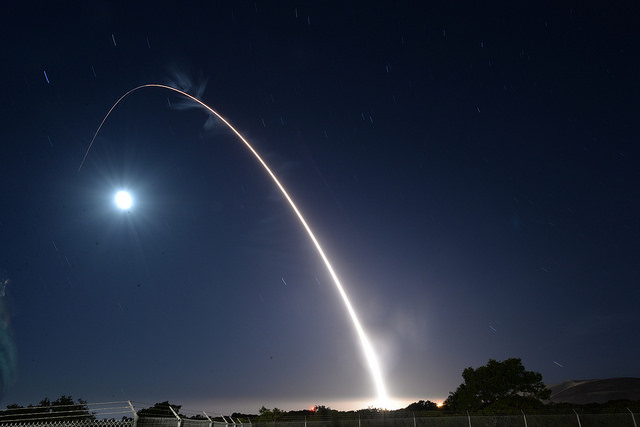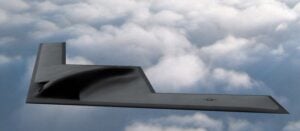The New U.S. Nuclear Triad Will Be A Bargain
Posted on

A Minuteman III ICBM operational test in May 2017
Is America’s nuclear arsenal too expensive? The Congressional Budget Office (CBO) released a report that concludes the Trump Administration’s plans to operate, sustain and recapitalize the aging U.S. nuclear arsenal over 30 years would cost the American people $1.2 trillion in constant dollars.
The report explains ways in which delaying or cancelling the recapitalization of parts of the triad would provide “savings,” including for the land-based intercontinental ballistic missile (ICBM) leg. The report claims that by delaying the new system, the Ground-based Strategic Deterrent (GBSD), and once again refurbishing the 1970s-vintage Minuteman III ICBM, taxpayers would “save” $17 billion through 2046. The report also notes that such a delay would only push the costs of the new ICBM out beyond 2046, requiring Americans to pay $42 billion to make up for the deferred modernization of our land-based missiles.
Members of Congress should not be intimidated by these numbers. They are right to stick with the modernization plan laid out by the Obama Administration and supported in the Trump Administration’s budget for two important reasons. One, nuclear deterrence is the nation’s primary security guarantee in this increasingly complex threat environment, and the current plan will still be more cost effective than alternative ones.
There is broad bi-partisan consensus that nuclear deterrence remains the foremost priority for the Pentagon. Defense Secretary James Mattis said: “One thing’s for certain, the number one priority of the Department of Defense is that we maintain a safe, secure and effective nuclear deterrent so we make certain those weapons are never used.” Similarly, Defense Secretary Ash Carter said, “America’s nuclear deterrent is the bedrock of our security. While this mission isn’t in the headlines every day, as I see it, we’re in real trouble if it ever is. It remains the highest priority of the Department of Defense.” A reliable and flexible, and therefore credible deterrent requires us to modernize the triad.
 The threats facing the United States and U.S. allies today are varied and complex. Great powers are establishing patterns of provocations and demonstrating a willingness to violate international treaties and agreements. Rogue nations with penchants for proliferation have chemical and biological weapons and are pursuing or testing nuclear weapons. Allies on the doorstep of these strategic threats need constant reassurance of the U.S. commitment to the nuclear umbrella.
The threats facing the United States and U.S. allies today are varied and complex. Great powers are establishing patterns of provocations and demonstrating a willingness to violate international treaties and agreements. Rogue nations with penchants for proliferation have chemical and biological weapons and are pursuing or testing nuclear weapons. Allies on the doorstep of these strategic threats need constant reassurance of the U.S. commitment to the nuclear umbrella.
Following plans developed during the Bush Administration, and supported by Congress, the Obama Administration moved forward with programs for new air and sea-based legs of the nuclear triad in the form of the Columbia-class ballistic missile submarine and the B-21 Raider long-range strike bomber. It also proposed replacement of the obsolescent Minuteman ICBM with the GBSD. In its fiscal 2018 budget request, the Trump Administration increased funding for GBSD, which is often referred to as the backbone of the U.S. triad.
Secretary Mattis has emphasized the need for GBSD and has warned about the dangers of failing to fully resource this key component of the strategic deterrent force. However, since the CBO, think tanks, and former government officials have questioned the priority and funding for GBSD, it’s worth reiterating why this specific program is so important to the overall deterrence mission.
 The United States currently has 400 Minuteman III ICBMs in silos spread across five states. A key value of America’s ICBM force is its contribution to nuclear stability — the sheer number of missile silos makes it impossible for a nuclear adversary to believe it can carry out a pre-emptive strike against them that will successfully destroy the land-based leg of the triad. Without the ICBM force, however, even small states might be more tempted to consider attempting to disarm the United States by hitting a handful of targets: bomber bases and two nuclear missile submarine ports. The ICBMs are critical to maintaining stability in nuclear deterrence.
The United States currently has 400 Minuteman III ICBMs in silos spread across five states. A key value of America’s ICBM force is its contribution to nuclear stability — the sheer number of missile silos makes it impossible for a nuclear adversary to believe it can carry out a pre-emptive strike against them that will successfully destroy the land-based leg of the triad. Without the ICBM force, however, even small states might be more tempted to consider attempting to disarm the United States by hitting a handful of targets: bomber bases and two nuclear missile submarine ports. The ICBMs are critical to maintaining stability in nuclear deterrence.
To be fully functional, this system requires more than just missiles. As the only leg of the triad on constant alert, the system is composed of launch facilities, sophisticated guidance systems and secure command, control, and communications. Originally fielded in the 1960s and 1970s, these systems have been the subject of multiple “service life extension programs” (SLEPs) to keep them operational – if not fully up to date with current technologies.
The 2010 Nuclear Posture Review (NPR) called for an Air Force Analysis of Alternatives on modernizing the current ICBM fleet. It concluded that developing and fielding a new missile, replacing the obsolescent Minuteman was a prudent path for both strategic and cost reasons.
Cancelling the program entirely or attempting one more time to stretch the service life of the Minuteman are (and should remain) non-starters. Thus, the central issue is continuing the GBSD program of record on schedule or imposing a costly delay. But suggestions supporting that delay by positing that only 400 ICBMs are needed, or that the current inventory can be extended by reducing the number of test each year, are wrong.

B-21 Raider artist rendering
First, strategic planners are using 450 missiles as the requirement for the GBSD, one missile for each existing silo. While it is true that under the New START treaty, the United States has capped the fielded ICBM force at 400 missiles, nothing in that Treaty precludes the United States from adjusting the weapons system mix within the triad. Moreover, under current testing schedules, the United States will drop below 450 missiles around 2028. To maintain the 450 threshold, the United States would need to produce new missiles before the dip.
Trying to extend the ICBM inventory over the years by reducing the number of tests per by extending the GBSD program’s timeline by a few years is risky. The Air Force has been asking for more tests, returning to a rate of seven per year, rather than the current four. Indeed, the longer the service life of the Minuteman III is extended – the older the missiles get – the more frequently they will need to be tested. If a program delay were to be considered, it would have to be coupled with an increased number of tests, not fewer.
Far from delaying it, the United States should accelerate GBSD. The objective of deterrence should drive the budget, not the other way around—and the strategy underwriting those objectives includes the prompt modernization of all three legs of the nuclear triad. In view of this, $1.2 trillion, or roughly 6 percent of the entire defense budget, to operate, sustain, and recapitalize the nuclear deterrent is a bargain, and one Americans should eagerly accept.
Rebeccah Heinrichs, a senior fellow at the Hudson Institute, is an expert in nuclear deterrence and missile defense. You can follow Rebeccah on Twitter at @RLHeinrichs
Subscribe to our newsletter
Promotions, new products and sales. Directly to your inbox.
